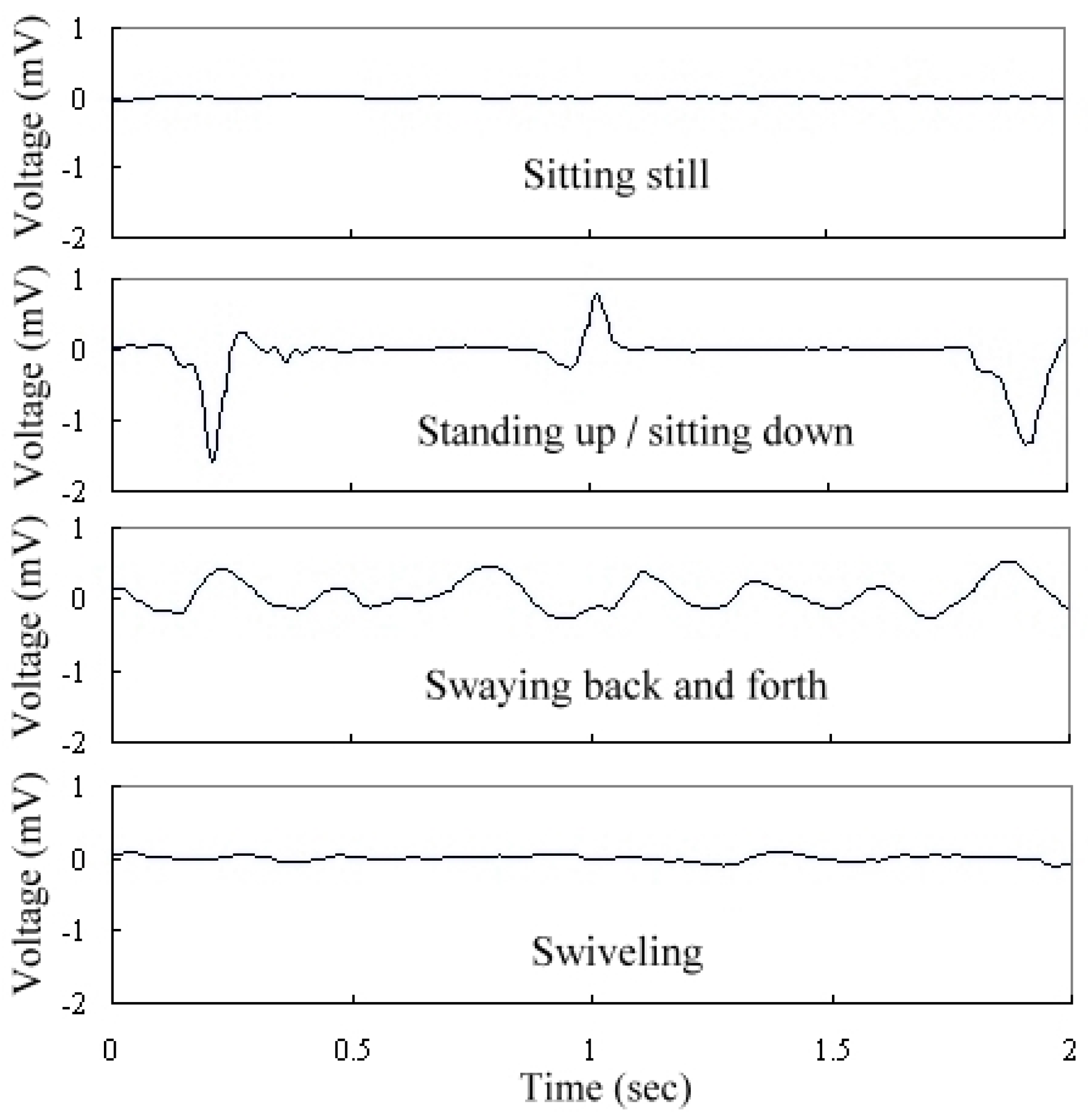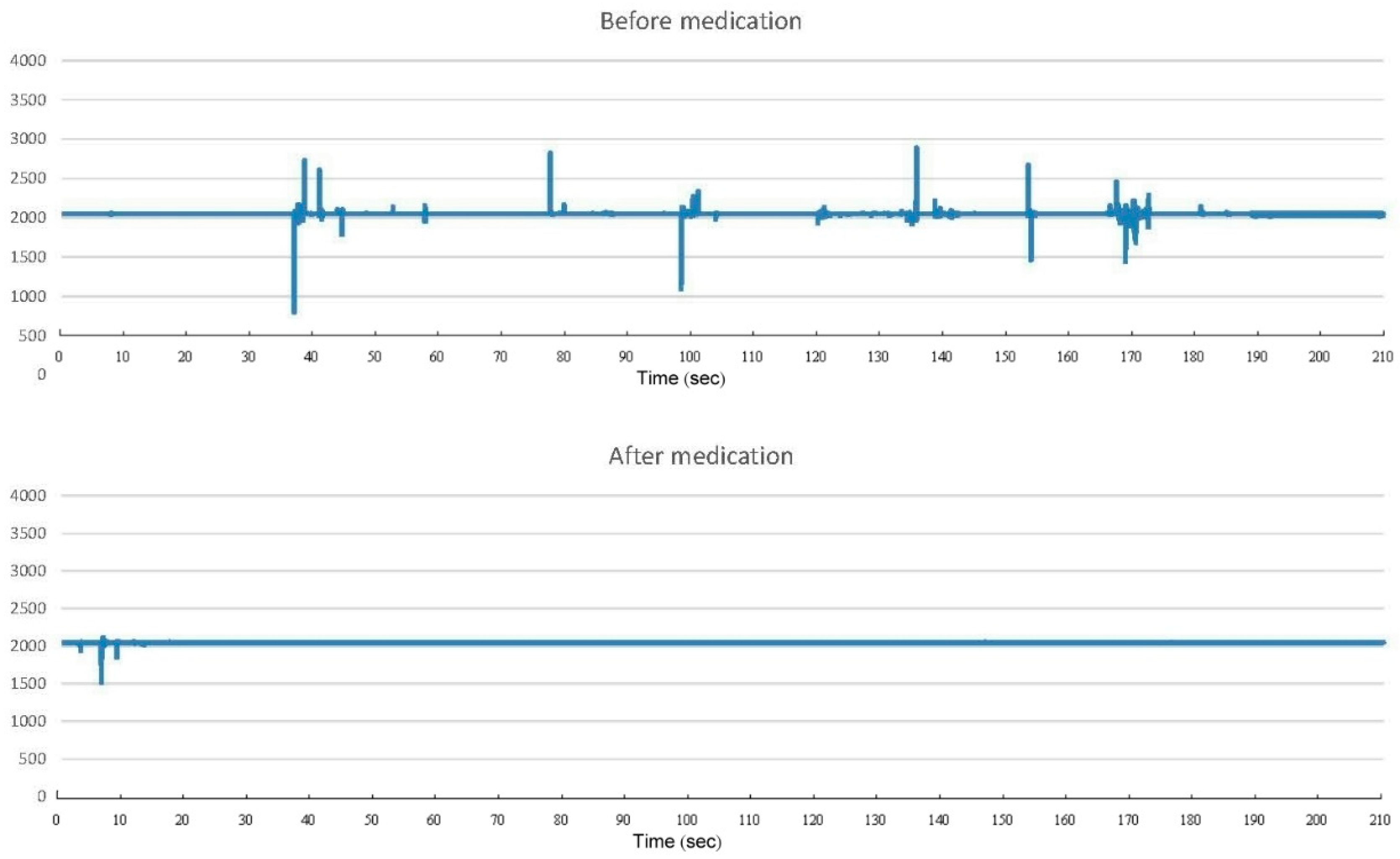Objective Evaluation of Therapeutic Effects of ADHD Medication by Analyzing Movements Using a Smart Chair with Piezoelectric Material
Abstract
1. Introduction
2. Patients and Methods
Patients
3. Results
4. Discussion
5. Conclusions
Author Contributions
Funding
Institutional Review Board Statement
Informed Consent Statement
Data Availability Statement
Acknowledgments
Conflicts of Interest
References
- Ng, Q.X.; Ho, C.Y.X.; Chan, H.W.; Yong, B.Z.J.; Yeo, W.-S. Managing childhood and adolescent attention-deficit/hyperactivity disorder (ADHD) with exercise: A systematic review. Complement. Ther. Med. 2017, 34, 123–128. [Google Scholar] [CrossRef] [PubMed]
- Aldemir, R.; Demirci, E.; Bayram, A.K.; Canpolat, M.; Ozmen, S.; Per, H.; Tokmakci, M. Evaluation of two types of drug treatment with QEEG in children with ADHD. Transl. Neurosci. 2018, 9, 106–116. [Google Scholar] [CrossRef]
- Jensen, P.S. A 14-month randomized clinical trial of treatment strategies for attention-deficit/hyperactivity disorder. Arch. General Psychiatry 1999, 56, 1073–1086. [Google Scholar]
- Sonuga-Barke, E.; Coghill, D. Stimulant Drug Effects on Attention Deficit/Hyperactivity Disorder: A Review of the Effects of Age and Sex of Patients. Curr. Pharm. Des. 2010, 16, 2424–2433. [Google Scholar] [CrossRef]
- Swanson, J.M.; Kraemer, H.C.; Hinshaw, S.P.; Arnold, L.E.; Conners, C.K.; Abikoff, H.B.; Clevenger, W.; Davies, M.; Elliott, G.R.; Greenhill, L.L.; et al. Clinical Relevance of the Primary Findings of the MTA: Success Rates Based on Severity of ADHD and ODD Symptoms at the End of Treatment. J. Am. Acad. Child. Adolesc. Psychiatry 2001, 40, 168–179. [Google Scholar] [CrossRef]
- Wolraich, M.L.; Lambert, W.; Doffing, M.A.; Bickman, L.; Simmons, T.; Worley, K. Psychometric Properties of the Vanderbilt ADHD Diagnostic Parent Rating Scale in a Referred Population. J. Pediatr. Psychol. 2003, 28, 559–568. [Google Scholar] [CrossRef]
- Woolsey, C.; Smoldon, J.; Devney, R. Initial development of an attention-deficit/hyperactivity disorder visual analog scale for rapid assessment of medication effects. J. Am. Assoc. Nurse Pract. 2020, 32, 8–14. [Google Scholar] [CrossRef]
- Staab, W.; Hottowitz, R.; Sohns, C.; Sohns, J.M.; Gilbert, F.; Menke, J.; Niklas, A.; Lotz, J. Accelerometer and Gyroscope Based Gait Analysis Using Spectral Analysis of Patients with Osteoarthritis of the Knee. J. Phys. Ther. Sci. 2014, 26, 997–1002. [Google Scholar] [CrossRef] [PubMed]
- Zollinger, M.; Degache, F.; Currat, G.; Pochon, L.; Peyrot, N.; Newman, C.J.; Malatesta, D. External Mechanical Work and Pendular Energy Transduction of Overground and Treadmill Walking in Adolescents with Unilateral Cerebral Palsy. Front. Physiol. 2016, 7, 121. [Google Scholar] [CrossRef] [PubMed]
- Ossig, A.A.C.; Antonini, A.; Buhmann, C.; Classen, J.; Csoti, J.A.; Falkenburger, B.; Schwarz, M.; Winkler, J.; Storch, A. Wearable sensor-based objective assessment of motor symptoms in Parkinson’s disease. J. Neural Transm. 2016, 123, 57–64. [Google Scholar] [CrossRef]
- Capela, N.A.; Lemaire, E.D.; Baddour, N.; Rudolf, M.; Goljar, N.; Burger, H. Evaluation of a smartphone human activity recognition application with able-bodied and stroke participants. J. Neuroeng. Rehabil. 2016, 13, 1–10. [Google Scholar] [CrossRef] [PubMed]
- Tseng, M.H.; Henderson, A.; Chow, S.M.K.; Yao, G. Relationship between motor proficiency, attention, impulse, and activity in children with ADHD. Dev. Med. Child. Neurol. 2004, 46, 381–388. [Google Scholar] [CrossRef]
- Wood, A.C.; Asherson, P.; Rijsdijk, F.; Kuntsi, J. Is overactivity a core feature in ADHD? Familial and receiver operating charac-teristic curve analysis of mechanically assessed activity level. J. Am. Acad. Child. Adolesc. Psychiatry 2009, 48, 1023–1030. [Google Scholar] [CrossRef]
- Tunstall, M.J.; Oorschot, D.E.; Kean, A.; Wickens, J.R. Inhibitory Interactions Between Spiny Projection Neurons in the Rat Striatum. J. Neurophysiol. 2002, 88, 1263–1269. [Google Scholar] [CrossRef] [PubMed]
- Cospito, J.; Kultas-Ilinsky, K. Synaptic organization of motor corticostriatal projections in the rat. Exp. Neurol. 1981, 72, 257–266. [Google Scholar] [CrossRef]
- Heilbronner, S.R.; Rodriguez-Romaguera, J.; Quirk, G.J.; Groenewegen, H.J.; Haber, S.N. Circuit-Based Corticostriatal Homologies Between Rat and Primate. Biol. Psychiatry 2016, 80, 509–521. [Google Scholar] [CrossRef] [PubMed]
- Künzle, H. Bilateral projections from precentral motor cortex to the putamen and other parts of the basal ganglia. An autoradiographic study inMacaca fascicularis. Brain Res. 1975, 88, 195–209. [Google Scholar] [CrossRef]
- Künzle, H. An Autoradiographic Analysis of the Efferent Connections from Premotor and Adjacent Prefrontal Regions (Areas 6 and 9) in Macaca fascicularis. Brain Behav. Evol. 1978, 15, 185–209. [Google Scholar] [CrossRef]
- Szabo, J. The efferent projections of the putamen in the monkey. Exp. Neurol. 1967, 19, 463–476. [Google Scholar] [CrossRef]
- Giedd, J.N.; Blumenthal, J.; Molloy, E.; Castellanos, F. Brain Imaging of Attention Deficit/Hyperactivity Disorder. Ann. N. Y. Acad. Sci. 2006, 931, 33–49. [Google Scholar] [CrossRef]
- Arnt, J. Hyperactivity following injection of a glutamate agonist and 6, 7-ADTN into rat nucleus accumbens and its inhibition by THIP. Life Sci. 1981, 28, 1597–1603. [Google Scholar] [CrossRef]
- Swanson, C.J.; Kalivas, P.W. Regulation of locomotor activity by metabotropic glutamate receptors in the nucleus accumbens and ventral tegmental area. J. Pharmacol. Exp. Ther. 2000, 292, 406–414. [Google Scholar]
- Austin, M.C.; Kalivas, P.W. The effect of cholinergic stimulation in the nucleus accumbens on locomotor behavior. Brain Res. 1988, 441, 209–214. [Google Scholar] [CrossRef]
- Costall, B.; Domeney, A.M.; Naylor, R.J. Locomotor hyperactivity caused by dopamine infusion into the nucleus accumbens of rat brain: Specificity of action. Psychopharmacol. 1984, 82, 174–180. [Google Scholar] [CrossRef]
- Worbe, Y.; Baup, N.; Grabli, D.; Chaigneau, M.; Mounayar, S.; McCairn, K.; Féger, J.; Tremblay, L. Behavioral and Movement Disorders Induced by Local Inhibitory Dysfunction in Primate Striatum. Cereb. Cortex 2008, 19, 1844–1856. [Google Scholar] [CrossRef] [PubMed]
- Wong, L.S.; Eshel, G.; Dreher, J.; Ong, J.; Jackson, D.M. Role of dopamine and GABA in the control of motor activity elicited from the rat nucleus accumbens. Pharmacol. Biochem. Behav. 1991, 38, 829–835. [Google Scholar] [CrossRef]
- Elahi, H.; Eugeni, M.; Gaudenzi, P. A Review on Mechanisms for Piezoelectric-Based Energy Harvesters. Energies 2018, 11, 1850. [Google Scholar] [CrossRef]
- Tsikriteas, Z.M.; Roscow, J.I.; Bowen, C.R.; Khanbareh, H. Flexible ferroelectric wearable devices for medical applications. iScience 2021, 24, 101987. [Google Scholar] [CrossRef] [PubMed]
- Trung, T.Q.; Lee, N.-E. Flexible and Stretchable Physical Sensor Integrated Platforms for Wearable Human-Activity Monitoringand Personal Healthcare. Adv. Mater. 2016, 28, 4338–4372. [Google Scholar] [CrossRef]
- Jerrentrup, L.; Canisius, S.; Wilhelm, S.; Kesper, K.; Ploch, T.; Vogelmeier, C.; Greulich, T.; Becker, H.F. Work of Breathing in Fixed and Pressure Relief Continuous Positive Airway Pressure (C-Flex™): A post hoc Analysis. Respiration 2016, 93, 23–31. [Google Scholar] [CrossRef]
- Chandel, V.; Singhal, S.; Sharma, V.; Ahmed, N.; Ghose, A. PI-Sole: A Low-Cost Solution for Gait Monitoring Using Off-The-Shelf Piezoelectric Sensors and IMU. In Proceedings of the 2019 41st Annual International Conference of the IEEE Engineering in Medicine and Biology Society (EMBC), Berlin, Germany, 23–27 July 2019; Volume 2019, pp. 3290–3296. [Google Scholar]
- Bussing, R.; Fernandez, M.; Harwood, M.; Hou, W.; Garvan, C.W.; Eyberg, S.M.; Swanson, J.M. Parent and teacher SNAP-IV ratings of attention deficit hyperactivity disorder symptoms: Psychometric properties and normative ratings from a school district sample. Assessment 2008, 15, 317–328. [Google Scholar] [CrossRef] [PubMed]
- Wagner, D.J.; McLennan, J.D. An Alternative Approach to Scoring the MTA-SNAP-IV to Guide Attention-Deficit/Hyperactivity Disorder Medication Treatment Titration towards Symptom Remission: A Preliminary Consideration. J. Child. Adolesc. Psychopharmacol. 2015, 25, 749–753. [Google Scholar] [CrossRef]
- Gau, S.S.-F.; Shang, C.-Y.; Liu, S.-K.; Lin, C.-H.; Swanson, J.M.; Liu, Y.-C.; Tu, C.-L. Psychometric properties of the Chinese version of the Swanson, Nolan, and Pelham, version IV scale—Parent form. Int. J. Methods Psychiatr. Res. 2008, 17, 35–44. [Google Scholar] [CrossRef] [PubMed]
- Inoue, Y.; Ito, K.; Kita, Y.; Inagaki, M.; Kaga, M.; Swanson, J.M. Psychometric properties of Japanese version of the Swanson, Nolan, and Pelham, version-IV Scale-Teacher Form: A study of school children in community samples. Brain Dev. 2014, 36, 700–706. [Google Scholar] [CrossRef]
- Granana, N.; Richaudeau, A.; Gorriti, C.R.; O’Flaherty, M.; Scotti, M.E.; Sixto, L.; Allegri, R.; Fejerman, N. Assessment of attention deficit hyperactivity: SNAP-IV scale adapted to Argentina. Revista Panamericana De Salud Publica Pan Am. J. Public Health 2011, 29, 344–349. [Google Scholar] [CrossRef] [PubMed]
- Spitzer, L.R.; Williams, J.B.W. Diagnostic and Statistical Manual of Mental Disorders, 3rd ed.; American Psychiatric Association: Washington, DC, USA, 1980. [Google Scholar]
- American Psychiatric Association. Diagnostic and Statistical Manual of Mental Disorders. BMC Med. 2013, 17, 133–137. [Google Scholar]
- Costa, D.S.; de Paula, J.J.; Malloy-Diniz, L.F.; Romano-Silva, M.A.; Miranda, D.M. Parent SNAP-IV rating of atten-tion-deficit/hyperactivity disorder: Accuracy in a clinical sample of ADHD, validity, and reliability in a Brazilian sample. J. Pediatr. 2018, 95, 736–743. [Google Scholar] [CrossRef] [PubMed]
- Hall, C.L.; Guo, B.; Valentine, A.Z.; Groom, M.J.; Daley, D.; Sayal, K.; Hollis, C. The Validity of the SNAP-IV in Children Displaying ADHD Symptoms. Assessment 2019, 27, 1258–1271. [Google Scholar] [CrossRef]



| Sex (M/F) | Age | Subtype (C/I) | SNAP Score Before Medication | SNAP Score After Medication | Reduction Percentage |
|---|---|---|---|---|---|
| 18/4 | 8y4m ± 2y6m | 20/2 | 42.61 ± 12.05 (parents) | 37.72 ± 12.72 (parents) | 11.48% |
| 38.76 ± 11.81 (teacher) | 32.15 ± 15.19 (teacher) | 17.05% |
| Parameters | Before Treatment | After Treatment | Reduction Rate | p Value |
|---|---|---|---|---|
| Inattentiveness (P) | 16.00 ± 5.46 | 14.28 ± 4.78 | 10.75% | 0.3521 |
| Hyperactivity (P) | 15.22 ± 5.27 | 12.00 ± 5.41 | 21.16% | 0.0147 * |
| Oppositional (P) | 11.39 ± 5.02 | 10.89 ± 5.81 | 4.39% | 0.7088 |
| Inattentiveness (T) | 15.00 ± 4.66 | 15.46 ± 5.49 | −3.07% | 0.7921 |
| Hyperactivity (T) | 14.08 ± 7.12 | 9.62 ±7.10 | 31.68% | 0.0330 * |
| Oppositional (T) | 9.69 ± 5.38 | 7.08 ± 5.58 | 26.93% | 0.076 |
| Before Treatment | After Treatment | Reduction Rate | p Value | |
|---|---|---|---|---|
| Variance | 2239.6 ± 3314.5 | 480.36 ± 871.35 | 78.55% | 0.0067 * |
| Zero crossing rate | 1.0112 ± 0.7547 | 0.4499 ± 0.5588 | 55.49% | 0.0005 * |
| High energy rate | 0.5062 ± 0.2815 | 0.2883 ± 0.2644 | 43.05% | 0.0003 * |
Publisher’s Note: MDPI stays neutral with regard to jurisdictional claims in published maps and institutional affiliations. |
© 2021 by the authors. Licensee MDPI, Basel, Switzerland. This article is an open access article distributed under the terms and conditions of the Creative Commons Attribution (CC BY) license (https://creativecommons.org/licenses/by/4.0/).
Share and Cite
Yang, R.-C.; Wu, R.-C.; Chiang, C.-T.; Chiu, Y.-H.; Ouyang, C.-S.; Lin, Y.-T.; Lin, L.-C. Objective Evaluation of Therapeutic Effects of ADHD Medication by Analyzing Movements Using a Smart Chair with Piezoelectric Material. Appl. Sci. 2021, 11, 5478. https://doi.org/10.3390/app11125478
Yang R-C, Wu R-C, Chiang C-T, Chiu Y-H, Ouyang C-S, Lin Y-T, Lin L-C. Objective Evaluation of Therapeutic Effects of ADHD Medication by Analyzing Movements Using a Smart Chair with Piezoelectric Material. Applied Sciences. 2021; 11(12):5478. https://doi.org/10.3390/app11125478
Chicago/Turabian StyleYang, Rei-Cheng, Rong-Ching Wu, Ching-Tai Chiang, Yi-Hung Chiu, Chen-Sen Ouyang, Ying-Tong Lin, and Lung-Chang Lin. 2021. "Objective Evaluation of Therapeutic Effects of ADHD Medication by Analyzing Movements Using a Smart Chair with Piezoelectric Material" Applied Sciences 11, no. 12: 5478. https://doi.org/10.3390/app11125478
APA StyleYang, R.-C., Wu, R.-C., Chiang, C.-T., Chiu, Y.-H., Ouyang, C.-S., Lin, Y.-T., & Lin, L.-C. (2021). Objective Evaluation of Therapeutic Effects of ADHD Medication by Analyzing Movements Using a Smart Chair with Piezoelectric Material. Applied Sciences, 11(12), 5478. https://doi.org/10.3390/app11125478





